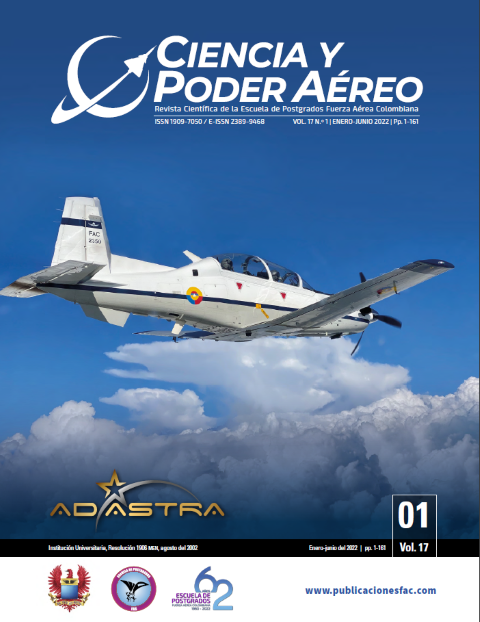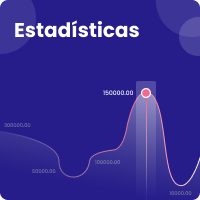Aproximación teórica a la definición del concepto de sitio atractivo de avifauna fuera del aeropuerto
DOI:
https://doi.org/10.18667/cienciaypoderaereo.743Palabras clave:
área de influencia aeroportuaria, hábitat atrayente de fauna, peligro aviario, sistema de análisis del riesgoResumen
La mayor parte de los impactos entre aeronaves y fauna ocurre dentro de los aeropuertos; sin embargo, casi la mitad de los impactos con daño se presenta fuera de estos. Por ello, los programas de peligro aviario deben considerar seriamente las zonas externas a los aeropuertos para lograr una gestión completa del riesgo de impacto. Pero estos programas presentan varias limitaciones para su implementación en el exterior, entre estas la falta de una definición precisa de la noción de hábitat atrayente de fauna fuera del aeropuerto, lo que reduce el concepto a un nivel intuitivo que obstaculiza la optimización del sistema de análisis del riesgo. Esto último impide identificar claramente las zonas que se han de evaluar y, posteriormente, manejar con la modificación de hábitats. Para abordar este problema, se propone el concepto de sitio atractivo de avifauna (SAA), definido como el lugar en el área de influencia aeroportuaria que presente, confirmada y regularmente, una bandada de al menos cincuenta aves voladoras y riesgosas. Dicha propuesta puede significar un importante adelanto para la seguridad aérea desde una gestión eficiente del riesgo de impacto por fauna fuera del aeropuerto.
Descargas
Referencias
Allan, J. R. (2000). A protocol for bird strike risk assessment at airports. International Bird Strike Proceedings, 25(11), 29-46. http://citeseerx.ist.psu.edu/viewdoc/download?doi=10.1.1.199.3893&rep=rep1&type=pdf
Andersson, K., Davis, C. A., Blackwell, B. F. y Heinen, J. R. (2017). Wetland bird abundance and safety implications for military aircraft operations. Wildlife Society Bulletin, 41(3), 424-433. https://doi.org/10.1002/wsb.804
Arthur, J. R. (2008). General principles of the risk analysis process and its application to aquaculture. En Food and Agriculture Organization (FAO), Understanding and applying risk analysis in aquaculture (pp. 20-25). FAO. https://www.researchgate.net/profile/Marnie-Campbell/publication/257307945_Introduced_marine_species_risk_assessment_-_aquaculture/links/00b7d524dfc3c13e18000000/Introduced-marine-species-risk-assessment-aquaculture.pdf#page=21
Australian Transport Safety Bureau (ATSB). (2019). Australian aviation wildlife strike statistics 2008-2017. https://www.atsb.gov.au/publications/2018/ar-2018-035/#footnote_3
Blackwell, B. F., Seamans, T. W., Fernández-Juricic, E., Devault, T. L. y Outward, R. J. (2019). Avian responses to aircraft in an airport environment. The Journal of Wildlife Management, 83(4), 893-901. https://doi.org/10.1002/jwmg.21650
Blackwell, B. F., DeVault, T. L., Fernández-Juricic, E. y Dolbeer, R. A. (2009). Wildlife collisions with aircraft: A missing component of land-use planning for airports. Landscape and Urban Planning, 93(1), 1-9. https://doi.org/10.1016/j.landurbplan.2009.07.005
Civil Aviation Authority (CAA). (2002). Aerodrome bird control. Report prepared by the Safety Regulation Group. Civil Aviation Authority.
Caro-Caro, C. I., Torres-Mora, M. A. y Barajas-Barbosa, M. P. (2014). Ecosistemas estratégicos y disponibilidad de hábitat de la avifauna del piedemonte llanero (Colombia), como posible peligro aviar. Revista Luna Azul, (39), 25-39. https://revistasojs.ucaldas.edu.co/index.php/lunazul/article/view/1758
Centro de Escritura Javeriano. (2018). Artículo de reflexión. https://www.javerianacali.edu.co/centro-escritura/recursos/articulo-de-reflexion
Coccon, F., Zucchetta, M., Bossi, G., Borrotti, M., Torricelli, P. y Franzoi, P. (2015). A land-use perspective for birdstrike risk assessment: The attraction risk index. PLoS One, 10(6). https://doi.org/10.1371/journal.pone.0128363
Corpac S.A. (2008). Programa para el control de la fauna silvestre aeropuerto Padre Aldamiz de Puerto Maldonado, Perú. http://www.corpac.gob.pe/Docs/gestion_ambiental/programa_control_fauna
Coy, H. (2016). Instructivo para la elaboración de artículos de reflexión para publicación en revistas de investigación. Corporación Unificada Nacional de Educación Superior. https://es.slideshare.net/hectorcoy/el-articulo-de-reflexin-65837295
Delfín-Alfonso, C. A., Gallina-Tessaro, S. A., y López-González, C. A. (2011). El hábitat: definición, dimensiones y escalas de evaluación para la fauna silvestre. En Gallina Tessaro, S. A., & López-González, C. A. (Eds). Manual de técnicas para el estudio de la fauna. Vol. 1 (pp. 351-377). Universidad Autónoma de Querétaro-Instituto de Ecología.
DeVault, T. L., Blackwell, B. F., Seamans, T. W., Begier, M. J., Kougher, J. D., Washburn, J. E., Miller, P. R. y Dolbeer, R. A. (2018). Estimating interspecific economic risk of bird strikes with aircraft. Wildlife Society Bulletin, 42(1), 94-101. https://doi.org/10.1002/wsb.859
DeVault, T. L., Blackwell, B. F., Seamans,T. W. y Belant, J. (2016). Identification of off-airport interspecific avian hazards to aircraft. The Journal of Wildlife Management, 80(4), 746-752. https://doi.org/10.1002/jwmg.1041
Dipilla, A. (2021). An aeroecological assessment of aircraft bird strike predictability using weather radar and citizen science [tesis de maestría, University of Science and Arts of Oklahoma]. Repositorio institucional USAO. https://hdl.handle.net/11244/329549
Dolbeer, R. A. (2011). Increasing trend of damaging bird strikes with aircraft outside the airport boundary: Implications for mitigation measures. Human-Wildlife Interactions, 5(2), 235-248. https://doi.org/10.26077/dnvb-x958
Dolbeer, R. A., Begier, M. J., Miller, P. R., Weller, J. R. y Anderson, A. L. (2021). Wildlife strikes to civil aircraft in the United States, 1990-2019 (No. DOT/FAA/TC-21/11). USDA.
El-Sayed, A. (2019). Bird strike in aviation: Statistics, analysis and management. John Wiley & Sons.
Federal Aviation Administration (FAA). (2020). Advisory Circular (AC) 150/5200-33C. Hazardous Wildlife Attractants on or Near Airports. https://www.faa.gov/documentLibrary/media/Advisory_Circular/150-5200-33C.pdf
Fernández-Juricic, E., Brand, J., Blackwell, B. F., Seamans, T. W. y DeVault, T. L (2018). Species with greater aerial maneuverability have higher frequency of collisions with aircraft: A comparative study. Frontiers in Ecology and Evolution, 6(17). https://doi.org/10.3389/fevo.2018.00017
Gerringer, M., Lima, S. y DeVault, T. (2016). Evaluation of an avian radar system in a midwestern landscape. Wildlife Society Bulletin, 40(1), 150-159. https://doi.org/10.1002/wsb.614
Godínez, E. (2018). Aves y aeronaves: riesgos y peligros. Kindle, Amazon.
Government of Canada. (2019). Canada Bird Strike Information System (CBSIS). https://wwwapps.tc.gc.ca/Saf-Sec-Sur/2/bsis/
Hasılcı, Z. y Boğoçlu, M. (2020). Determining the effect of bird parameters on bird strikes to commercial passenger aircraft using the central composite design method. International Journal of Aeronautics and Astronautics, 2(1), 1-8 . https://dergipark.org.tr/en/pub/ijaa/issue/62592/945053
Hernández-Silva, D., Pulido, M., Zuria, I., Gallina, S. y Sánchez-Rojas, G. (2018). El manejo como herramienta para la conservación y aprovechamiento de la fauna silvestre: Acceso a la sustentabilidad en México. Acta Universitaria, 28(4), 31-41. https://doi.org/10.15174/au.2018.2171
Hu, Y., Xing, P., Yang, F., Feng, G., Yang, G. y Zhang, Z. (2020). A birdstrike risk assessment model and its application at Ordos Airport, China. Scientific Reports, 10(1), 1-7. https://doi.org/10.1038/s41598-020-76275-z
International Civil Aviation Organization (ICAO). (2020). Doc. 9137. Airport Services Manual. Part 3. Wildlife Control Hazard Management. ICAO.
Jeffery, R. y Buschke, F. (2019). Urbanization around an airfield alters bird community composition, but not the hazard of bird-aircraft collision. Environmental Conservation, 46(2), 124-131. 10.1017/S0376892918000231
Maragakis, I. (2009). Bird population trends and their impact on aviation safety 1999-2008. European Aviation Safety Agency. https://skybrary.aero/sites/default/files/bookshelf/615.pdf
Marateo, G., Grilli, P., Ferretti, V. y Bouzas, N. (2011). Diagnóstico de riesgo aviario en un aeródromo de un aérea megadiversa del Perú. Revista Conexao SIPAER, 3(2), 203-227.
Martin, J. A., Belant, J. L., DeVault, T. L., Blackwell, B. F., Burger Jr., L. W., Riffell, S. K. y Wang, G. (2011). Wildlife risk to aviation: A multi-scale issue requires a multi-scale solution. Human-Wildlife Interactions, 5(2), 198-203. https://www.jstor.org/stable/24868880
Martín-Vélez, V., Mohring, B., Van Leeuwen, C. H. A., Shamoun-Baranes, J., Thaxter, C. B., Baert, J. M., Camphuysen, C. J. y Green, A. J. (2020). Functional connectivity network between terrestrial and aquatic habitats by a generalist waterbird, and implications for biovectoring. Science of the Total Environment, 705, 135886. https://doi.org/10.1016/j.scitotenv.2019.135886
Martínez Moreno, L. K. (2019). Planeación del suelo en torno al aeropuerto: consideraciones para un ordenamiento territorial compatible [tesis de maestría, Universidad Nacional de Colombia]. Repositorio institucional Unal. https://repositorio.unal.edu.co/handle/unal/69867
Matamoros, A. G. y Torres, C. A. (2014). Identificación de los factores de atracción de fauna en las proximidades del Aeropuerto Toncontín. Ciencias Espaciales, 7(2), 96-108. https://doi.org/10.5377/ce.v7i2.2522
Metz, I. C., Ellerbroek, J., Mühlhausen, T., Kügler, D. y Hoekstra, J. M. (2020). The Bird Strike Challenge. Aerospace, 7(3), 26. https://doi.org/10.3390/aerospace7030026
Metz, I. C., Ellerbroek, J., Mühlhausen, T., Kügler, D., Kern, S. y Hoekstra, J. M. (2021a). The Efficacy of Operational Bird Strike Prevention. Aerospace, 8(1), 17. https://doi.org/10.3390/aerospace8010017
Metz, I. C., Ellerbroek, J., Mühlhausen, T., Kügler, D. y Hoekstra, J. M. (2021b). Analysis of Risk-Based Operational Bird Strike Prevention. Aerospace, 8(2), 32. https://doi.org/10.3390/aerospace8020032
Ning, H. y Chen, W. (2014). Bird strike risk evaluation at airports. Aircraft Engineering and Aerospace Technology, 86(2), 129-137. https://doi.org/10.1108/AEAT-07-2012-0111
Novoselova, N. S., Novoselov, A. A., Macarrão, A., Gallo-Ortiz, G. y Silva, W. R. (2020). Remote sensing applications for abating aircraft-bird strike risks in Southeast Brazil. Human-Wildlife Interactions, 14(1), 8. https://doi.org/10.26077/3z5d-eb31
Ojasti, J. y Dallmeier, F. (2000). Manejo de Fauna Silvestre Neotropical. SI/MAB Series #5. Smithsonian Institution/MAB Biodiversity Program.
Pfeiffer, M. B., Blackwell, B. F. y DeVault, T. L. (2020). Collective effect of landfills and landscape composition on bird-aircraft collisions. Human-Wildlife Interactions, 14(1), 9. https://digitalcommons.usu.edu/cgi/viewcontent.cgi?article=1579&context=hwi
Pfeiffer, M. B., Kougher, J. y DeVault, T. L. (2018). Civil airports from a landscape perspective: A multi-scale approach with implications for reducing bird strikes. Landscape and Urban Planning, 4(9), 38-45. https://doi.org/10.1016/j.landurbplan.2018.07.004
Sadava, D., Heller, H., Orians, G., Purves, W. y Hillis, D. (2009). Vida. La ciencia de la biología. Editorial Médica Panamericana.
Shao, Q., Zhou, Y., Zhu, P., Ma, Y. y Shao, M. (2020a). Key factors assessment on bird strike density distribution in airport habitats: Spatial heterogeneity and geographically weighted regression model. Sustainability, 12(18), 7235. https://doi.org/10.3390/su12187235
Shao, Q., Zhou, Y. y Zhu, P. (2020b). Spatiotemporal analysis of environmental factors on the birdstrike risk in high plateau airport with multi-scale research. Sustainability, 12(22), 9357. https://doi.org/10.3390/su12229357
Smith, T. M. y Smith, R. L. (2007). Ecología. Propiedades de las poblaciones. Pearson Educación.
Sowden, R., Kelly, T. y Dudley, S. (2007). Airport bird hazard risk assessment process. 2007 Bird Strike Committee USA/Canada, 9th Annual Meeting, Kingston, Ontario. https://digitalcommons.unl.edu/birdstrike2007/8
Steele, W. K. y Weston, M. A. (2021). The assemblage of birds struck by aircraft differs among nearby airports in the same bioregion. Wildlife Research, 48(5), 422-455. https://doi.org/10.1071/WR20127
Van Gasteren, H., Krijgsveld, K. L., Klauke, N., Leshem, Y., Metz, I. C., Skakuj, M., Sorbi, S., Schekler, I. y Shamoun-Baranes, J. (2018). Aeroecology meets aviation safety: early warning systems in Europe and the Middle East prevent collisions between birds and aircraft. A Journal of Space and Time in Ecology, 42(5), 899-911. https://doi.org/10.1111/ecog.04125
Wang, J. y Herricks, E. E. (2012). Risk assessment of bird-aircraft strikes at commercial airports: Submodel development. Transportation Research Record, 2266(1), 78-84. https://doi.org/10.3141/2266-09
World Organization for Animal Health (OIE). (2019). Análisis del riesgo asociado a las importaciones. https://www.oie.int/fileadmin/Home/esp/Health_standards/tahc/current/chapitre_import_risk_analysis.pdf
Zhao, B., Wang, N., Fu, Q., Yan, H. y Wu, N. (2019). Searching a site for a civil airport based on bird ecological conservation: An expert-based selection (Dalian, China). Global Ecology and Conservation, 20, 1-12. https://doi.org/10.1016/j.gecco.2019.e00729
Zuluaga, S., Speziale, K. y Lambertucci, S. A. (2021). Global aerial habitat conservation post-COVID-19 anthropause. Trends in Ecology & Evolution, 36(4), 273-277. https://doi.org/10.1016/j.tree.2021.01.009
Publicado
Número
Sección
Licencia
Derechos de autor 2022 Escuela de Postgrados de la Fuerza Aérea Colombiana

Esta obra está bajo una licencia internacional Creative Commons Atribución 4.0.
Declaración de cesión de los derechos de autor a la revista
Los autores ceden la Revista los derechos de explotación (reproducción, distribución, comunicación pública y transformación) para explotar y comercializar la obra, entera o en parte, en todos los formatos y modalidades de explotación presentes o futuros, en todos los idiomas, por todo el periodo de vida de la obra y por todo el mundo.
Todos los contenidos publicados en la revista científica Ciencia y Poder Aéreo están sujetos a la licencia reconocimiento 4.0 Internacional de Creative Commons, cuyo texto completo se puede consultar en http://creativecommons.org/licenses/by/4.0/
La licencia permite a cualquier usuario descargar, imprimir, extraer, archivar, distribuir y comunicar públicamente este artículo, siempre y cuando el crédito se dé a los autores de la obra: a los autores del texto y a Ciencia y Poder Aéreo, Revista Científica de la Escuela de Postgrados de la Fuerza Aérea Colombiana. Excepto cuando se indique lo contrario, el contenido en este sitio es licenciado bajo una licencia Creative Commons Atribución 4.0 internacional.
Para usos de los contenidos no previstos en estas normas de publicación es necesario contactar directamente con el director o editor de la revista a través del correo cienciaypoderaereo@epfac.edu.
La Escuela de Postgrados de la Fuerza Aérea Colombiana y esta publicación no son responsables de los conceptos emitidos en los artículos, ni de los metadatos aportados ni de las filiaciones que los autores declaren, ya que esta es responsabilidad plena de los autores.






















